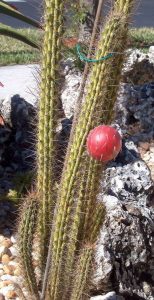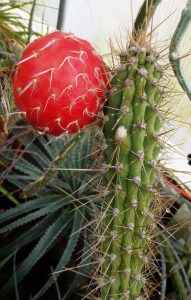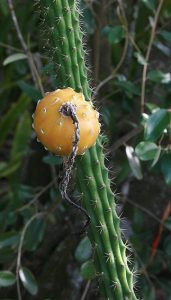
Harrisia simpsonii
Harrisia Trio: Endangered Edibles All
Just as it is important to know what to eat, it’s as important to know what not to eat, or if you do, how to do it right.
The Harrisias are three endangered cactus, all with edible fruit. Let’s say you are in a mangrove swamp, your canoe has floated away because you didn’t watch the changing tide. You also didn’t have the good sense to tell anyone where you were going or what you were going to do on your month off. Since no one lives within miles of you there is no cellphone tower nearby for your phone to work. After a week of resisting the fruit of these endangered species you succumb to your hunger. You find up to 1500 seeds in each one. Spread the seeds around, give them to your friends with green thumbs after you’re rescued. You will be rescued because you now have a mission, to help the endangered species that helped keep you going. Just don’t tell anyone with a badge you ate the fruit of an endangered species… kinda like eating Spotted Owl eggs….

Harrisia fragrans
Other than DNA testing, the only way to tell the Harrisia simpsonii (above left) from the H. arboriginium (below) is the former has fruit that ripens to red and the latter to yellow. The sweet smelling Harrisia fragrans (right) is rare because of development and is found in only one Florida County. And in the county it is found in only 10 or 11 spots. I became interested in the genus when I saw H. simpsonii while out kayaking on the Inland Waterway south of New Smyrna Beach, Florida. I thought it was an escaped ornamental. The red fruit stood out among the greenery, probably part of the plant’s strategy to attract creature attention and spread its seeds around.

Harrisia aboriginium
Harrisia (hair-RIS-ee-uh ) honors William Harris (1860-1920) of Jamaica who contributed greatly to our knowledge of the flora of that island. He was superintendent of the Public Gardens and Plantations of Jamaica. Arboriginium (ab-or-RIJ-in-um ) has been found on pre-Columbian shell mounts and that is why it is called arboriginium. Simpsonii simp-SON-ee-eye) honors south Florida naturalist Charles T. Simpson (1846-1932. See Simpson Stopper.) Fragrans (fray-granz) means fragrant.
Green Deane’s “Itemized” Plant Profile
IDENTIFICATION: Prickly apple and Apple cactus: Shrubby, to 12 feet tall, on the ground or on shells or the like, sometimes vine like, often branched, one to one and half inched through, cylindrical, with nine or 10 ridges, spines 3/4 to an inch long, in groups of 6 or 12. Flowers nocturnal, funnel shaped, white, no odor. Young pointed buds are covered with hair. Fruit oblate, dull red or yellow.
TIME OF YEAR: Nearly year round
ENVIRONMENT: Hammocks, mangrove swamps
METHOD OF PREPARATION: Fruit edible raw

